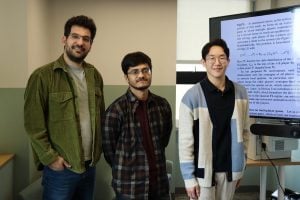
A new AI approach developed by Johns Hopkins experts aims to help independent AI systems with different priorities—such as large language models, robots, and energy companies—work together to achieve the best overall outcome–without compromising their individual goals. This new framework, called ‘Multiplayer Federated Learning (MpFL),’ uses game theory to foster cooperation between clients and players with competing priorities, with potential applications in fields ranging from energy and economics to multi-agent AI systems.
The team’s results appeared on the preprint site arXiv.
“Traditional federated learning—a machine learning setting where AI models learn from data across multiple devices without sharing full datasets—assumes full cooperation among clients. But in real-world applications, entities often have competing interests,” said TaeHo Yoon, a lead author of the study and postdoctoral fellow in the Whiting School of Engineering’s Department of Applied Mathematics and Statistics. “Our approach allows AI systems to optimize individual strategies to achieve a stable equilibrium, even with limited communication.”
The study addresses a fundamental challenge in large-scale strategic decision-making: how to enable thousands of competing entities to make smart decisions together without constantly sharing sensitive data. Traditional game theory assumes few players communicate fully, while federated learning involves a much larger number of players who communicate intermittently. The researchers’ new algorithm bridges these gaps, allowing entities to interact less often but still reach fair and balanced decisions overall.
“Our proposed algorithm, Per-Player Local Stochastic Gradient Descent (PEARL-SGD), ensures that each player updates their strategy locally based on their own past decisions and experiences, rather than relying on constant real-time communication with other players, significantly reducing communication cost,” explained co-author Nicolas Loizou, assistant professor of applied mathematics and statistics. “By carefully adjusting the learning rate—the factor that controls how much a player adjusts their strategy at each step—we can reach a stable outcome (equilibrium) without requiring excessive communication between players.”
One promising application of this research lies in improving how large language models (LLMs) communicate and make decisions. Current AI models, such as ChatGPT, need a lot of computing power to generate responses. The team’s approach could reduce the amount of data exchanged while ensuring the quality of the answers, leading to more efficient AI systems for automated negotiations, content creation, and strategic decision-making.
Future plans include expanding the framework to accommodate environments where players have varying capabilities and objectives and refining its optimization techniques to handle more complicated scenarios.
“Our goal is to create AI learning/training frameworks that can operate effectively in competitive and resource-constrained environments,” said Yoon. “Whether in economic modeling, smart grids, or AI debates, reducing communication costs required for achieving equilibrium is key to the future of multi-agent learning.”
The research team also included Sayantan Choudhury, a graduate student in the Department of Applied Mathematics and Statistics.
This study was supported by the Chen Family Dissertation Fellowship and CISCO Research.